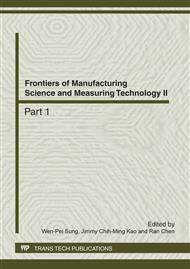p.1082
p.1086
p.1090
p.1094
p.1100
p.1104
p.1108
p.1112
p.1116
The Forward Kinematics Solution of Track Irregularity Simulator
Abstract:
By means of the bionic optimization method PSO, the particle swarm displacement tracking model was established by this paper according to the displacement constraint conditions of the track irregularity simulator actuators, which took the difference between the given length of the forward kinematics solution and the inverse kinematics solution as the optimization objective. The population global searching and optimization was carried out through the PSO toolbox based on matlab and the compiling optimization function procedure, in order to realize the dynamic tracking of the position parameters and the forward kinematics solution of the 6-Dof loading platform. The accuracy of forward kinematics solution model and the PSO procedure discussed in this paper was proved by the example.
Info:
Periodical:
Pages:
1100-1103
Citation:
Online since:
April 2012
Authors:
Price:
Сopyright:
© 2012 Trans Tech Publications Ltd. All Rights Reserved
Share:
Citation:


